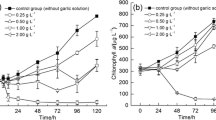Abstract
The toxicity of phenol and its nitrosubstituentso-nitrophenol (ONP),m-nitrophenol (MNP), andp-nitrophenol (PNP) was determined towards growth and metabolic activities of a diazotrophic cyanobacterium,Nostoc linckia, isolated from soil. Nitrophenols, but not phenol significantly inhibited the production of cell constituents (chlorophylla, protein and carbohydrate),14CO2 uptake and activities of nitrate reductase, nitrogenase, and glutamine synthetase. Growth of the organism under photoheterotrophic conditions (0.1% acetate) did not reduce the toxicity of nitrophenols. However, the addition of 10 μM adenosine triphosphate (ATP) to MNP treatments reversed the toxicity. Transmission electron microscopy revealed the secretion of mucous around the filament and induction of spore formation in the cultures subjected to nitrophenol toxicity.
Similar content being viewed by others
References
Albert A (1979) Selective toxicity. John Wiley and Sons, NY
Allen MM (1968) Simple conditions for growth of unicellular bluegreen algae on plates. J Phycol 4:1–4
Barik S (1984) Metabolism of insecticides by microorganisms. In: Lal S (ed) Insecticide microbiology. Springer-Verlag, Berlin, pp 87–130
Barik S, Siddaramappa R, Sethunathan N (1976) Metabolism of nitrophenols by bacteria isolated from parathion-amended flooded soil. Antonie van Leeuwenhock J Microbiol Serol 42:461–470
Barnes H, Folkard AR (1951) The determination of nitrites. Analyst 76:559–603
Bothe H (1982) Nitrogen fixation. In: Carr NG, Whitton BA (eds) The biology of cyanobacteria. Blackwell Scientific Publications, Oxford, pp 87–104
Bruhn C, Lenke H, Knackmus HJ (1987) Nitrosubstituted aromatic compounds as nitrogen source for bacteria. Appl Environ Microbiol 53:208–210
Camm EL, Stein JR (1974) Some aspects of the nitrogen metabolism ofNodularia spumigena (Cyanophyceae). Can J Bot 52:719–726
Fay P (1976) Factors influencing dark nitrogen fixation in blue-green algae. Appl Environ Microbiol 31:376–379
Fedtke C (1982) Biochemistry and physiology of herbicide action. Springer-Verlag, Berlin
Fisher RW, Wölk CP (1976) Substance stimulating the differentiation of spores of the blue-green algaCylindrospermum licheniforme. Nature (Lond) 259:394–395
Haselkorn R (1978) Heterocysts. Annu Rev Plant Physiol 29:319
Hill GA, Robinson CW (1975) Substrate inhibition kinetics: Phenol degradation byPseudomonas putida. Biotechnol Bioeng 17:1599–1615
Holden M (1976) Chlorophylls. In: Goodwin TW (ed) Chemistry and biochemistry of plant pigments. Academic Press, London, pp 1–39
Keith LH, Telliard WA (1979) Priority pollutants 1-a perspective review. Environ Sci Technol 13:416–423
Khoja TM, Whitton BA (1975) Heterotrophic growth of filamentous blue-green algae. Br Phycol J 10:139–148
Losada M, Guerrero MG (1979) The photosynthetic reduction of nitrate and its regulation. In: Barber J (ed) Photosynthesis in relation to model system. Elsevier/North Holland Biomedical Press, Amsterdam, pp 365–408
Lowry OH, Rosenbrough JJ, Farr AL, Randall RJ (1951) Protein measurement with Folin-phenol reagent. J Biol Chem 193:265–275
Malin G, Pearson HW (1988) Aerobic nitrogen fixation in aggregate forming cultures of the non-heterocystous cyanobacteriumMicrocoleus chthonoplastes. J Gen Microbiol 134:1755–1763
Megharaj M, Venkateswarlu K, Rao AS (1986) The toxicity of phenolics to soil algal population and toChlorella vulgaris andNostoc linckia. Plant Soil 96:197–203
—,—,— (1988) Effect of insecticides and phenolics on nitrogen fixation byNostoc linckia. Bull Environ Contam Toxicol 41:277–281
Molin G, Nilsson I (1985) Degradation of phenol byPseudomonas putida ATCC 11172 in continuous culture at different ratios of biofilm surface to culture volume. Appl Environ Microbiol 50:946–950
Munnecke DM, Hsieh DPH (1974) Microbial decontamination of parathion andp-nitrophenol in aqueous media. Appl Microbiol 28:212–217
Munnecke DM (1976) Enzymatic hydrolysis of organophosphatic insecticides, a possible pesticide disposal method. Appl Environ Microbiol 32:7–13
Ou LT (1985) Methyl parathion degradation and metabolism in soil: Influence of high soil water contents. Soil Biol Biochem 17:241–243
Pandey AK (1985) Effects of propanil on growth and cell constituents ofNostoc calcicola. Pestic Biochem Physiol 23:157–162
Reynolds ES (1963) The use of lead citrate at high pH as an electronopaque stain in electron microscopy. J Cell Biol 17:208–212
Sethunathan N, Yoshida T (1972) Conversion ofpara nitrophenol by diazinon-degrading bacterium,Flavobacterium sps. Inst Environ Tech Meet Proc 18:255–257
Shields LM, Durrell LW (1964) Algae in relation to soil fertility. Bot Rev 30:92–128
Spiro RG (1966) Analysis of sugars found in glycoproteins. Methods Enzymol 8:1–26
Spurr AR (1969) A low viscosity epoxy resin embedding medium for electron microscopy. J Ultrastruct Res 26:31–43
Stacey G, Tabita FR, Van Baalen C (1977) Nitrogen and ammonia assimilation in the cyanobacterium, purification of glutamine synthetase fromAnabaena sp strain CA. J Bacteriol 132:596–603
Stewart WDP, Mague T, Fitzerald GP, Burris RH (1971) Nitrogenase activity in Wisconsin lakes of different degrees of eutrophication. New Phytol 70:497–509
Stewart WDP (1977) Blue-green algae. In: Hardy RWF, Silver WS (eds) A treatise on dinitrogen fixation section III. Biology. John Wiley and Sons, New York, pp 63–123
Thomas JH, Mullineaux PM, Cronshaw AD, Chaplin AE, Gallon JR (1982) The effects of structural analogues of aminoacids on ammonium assimilation and acetylene reduction (nitrogen fixation) in Gloeocapsa (Gloeothece) sp. CCAP/1430/3. J Gen Microbiol 128:885–893
Zeyer J, Kearney PC (1984) Degradation ofo-nitrophenol andm-nitrophenol byPseudomonas putida. J Agric Fd Chem 32:238–242
Author information
Authors and Affiliations
Rights and permissions
About this article
Cite this article
Megharaj, M., Pearson, H.W. & Venkateswarlu, K. Toxicity of phenol and three nitrophenols towards growth and metabolic activities ofNostoc linckia, isolated from soil. Arch. Environ. Contam. Toxicol. 21, 578–584 (1991). https://doi.org/10.1007/BF01183881
Received:
Revised:
Issue Date:
DOI: https://doi.org/10.1007/BF01183881




